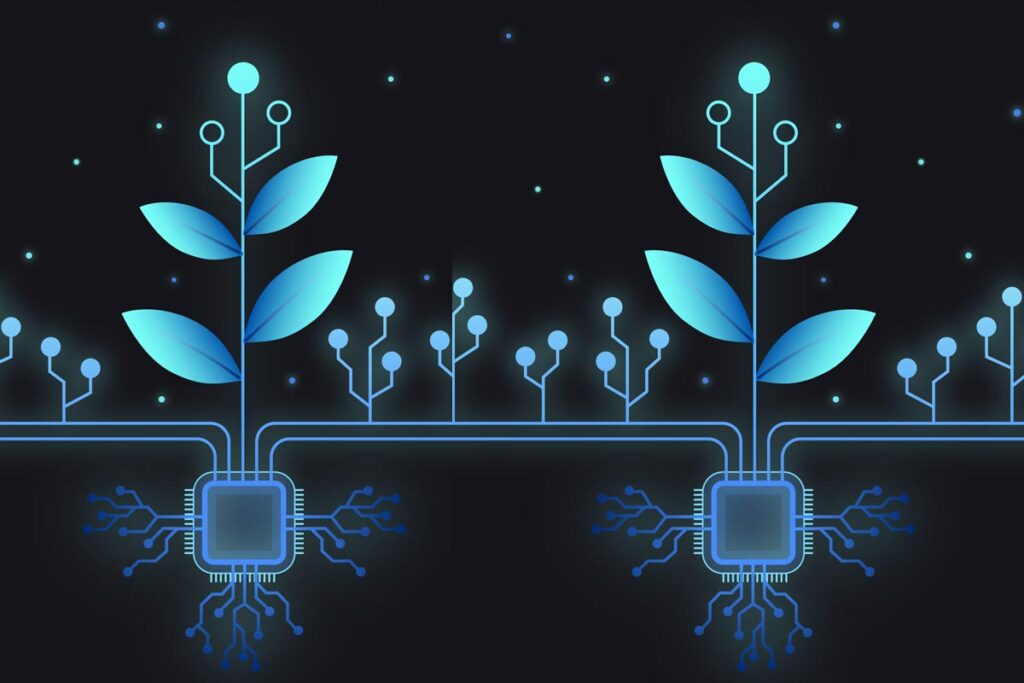Introduction
Agriculture is only one of several industries that have undergone radical change as a result of the Internet of Things (IoT). IoT technology has emerged as a powerful tool in modern farming practices, enabling farmers to make data-driven decisions, optimize resource utilization, and enhance crop yield.

In this article, we will explore smart ways to use IoT in agriculture, showcasing how this innovative technology is transforming traditional farming into a more efficient and sustainable practice.
1. Precision Agriculture
Precision agriculture, or smart farming, uses IoT sensors, GPS technology, and data analytics to gather real-time information about soil conditions, weather patterns, and crop health. This data helps farmers make precise decisions about irrigation, fertilization, and pest control, reducing resource wastage and increasing crop productivity.
IoT-enabled devices like soil moisture sensors and weather stations automate irrigation systems, conserving water and preventing over-irrigation, which can lead to soil degradation.
2. Crop Monitoring and Management
IoT-based crop monitoring solutions offer farmers the ability to remotely track and manage their crops. Drones equipped with cameras and sensors can be used to monitor large fields, capturing images and data that reveal crop health, pest infestations, and nutrient deficiencies. This enables farmers to take proactive measures to address issues before they negatively impact crop yields.
Additionally, IoT-enabled smart irrigation systems can adjust water distribution based on real-time crop needs, ensuring optimal moisture levels while conserving water resources through m2m sim cards connected with iot devices. Furthermore, the use of IoT devices for nutrient management allows farmers to apply fertilizers and other supplements more efficiently, reducing both costs and environmental impact.
3. Livestock Management
IoT applications in agriculture extend beyond crop management to livestock monitoring and management. IoT-enabled devices, such as smart collars and ear tags, can track the health and location of individual animals in real-time. Farmers can receive alerts about any deviations from normal behavior or health parameters, allowing for timely intervention and preventing disease outbreaks.
Furthermore, IoT technology can optimize feeding schedules and monitor the nutritional needs of livestock, ensuring they receive the right amount of feed at the right time. This not only enhances animal health but also increases the efficiency of livestock farming.
4. Supply Chain Optimization
IoT can play a pivotal role in streamlining the agricultural supply chain. By tracking the location and condition of produce from the farm to the consumer, farmers and distributors can ensure the freshness and quality of products. Temperature and humidity sensors in transportation containers can alert stakeholders to any deviations that may compromise product quality.
This level of visibility also helps reduce food waste by allowing for better inventory management and reducing spoilage during transit. It also facilitates transparency in the supply chain, allowing consumers to trace the origin and journey of the products they purchase through the IoT Management Platform.
5. Pest and Disease Management
Pest and disease outbreaks can devastate crops and lead to substantial financial losses for farmers. IoT technology offers proactive solutions for pest and disease management. Automated monitoring systems can detect early signs of infestations and diseases, allowing farmers to take swift action, such as targeted pesticide application or isolation of affected crops.
Additionally, predictive analytics can analyze historical data and environmental conditions to forecast potential pest and disease outbreaks. This enables farmers to implement preventive measures, reducing the reliance on chemical treatments and promoting sustainable farming practices.
6. Weather Forecasting and Risk Mitigation
Weather plays a critical role in agriculture, and IoT technology enhances weather forecasting accuracy. IoT weather stations collect real-time data on temperature, humidity, wind speed, and precipitation, enabling farmers to make informed decisions about planting, harvesting, and irrigation. IoT-based weather forecasting helps farmers mitigate risks from extreme weather events, allowing them to adjust planting schedules or protect crops from adverse conditions.
7. Remote Monitoring and Control
One of the most significant advantages of IoT in agriculture is the ability to remotely monitor and control farming operations. Farmers can access real-time data and control systems through mobile applications or web-based platforms, enabling them to manage their farms efficiently from anywhere.
Remote monitoring and control extend to areas such as irrigation systems, surveillance cameras, and livestock feeding systems. This convenience not only saves time but also reduces the need for on-site personnel and travel expenses.
8. Data Analytics and Decision Support
The vast amount of data collected through IoT devices in agriculture can be overwhelming. However, with the right data analytics tools, this data becomes a valuable resource for making informed decisions. Data analytics can provide insights into trends, crop performance, and resource utilization, helping farmers optimize their operations.
Moreover, machine learning algorithms can be trained to provide predictive recommendations based on historical data, further enhancing decision-making capabilities. Farmers can use these insights to fine-tune their farming practices and maximize crop yields while minimizing costs.
9. Sustainability and Environmental Benefits
IoT in agriculture contributes significantly to sustainability efforts. By optimizing resource usage, reducing waste, and adopting eco-friendly practices, farmers can minimize their environmental footprint. Efficient irrigation and nutrient management reduce water and chemical usage, while precision farming minimizes soil degradation.
Furthermore, IoT-enabled renewable energy solutions, such as solar-powered sensors and remote monitoring systems, can help reduce the reliance on fossil fuels and lower greenhouse gas emissions in farming operations.
10. Future Potential and Challenges
The potential of IoT in agriculture is vast, but it is not without its challenges. As IoT adoption grows, addressing issues related to data security and privacy becomes paramount. Farmers must ensure that sensitive information is protected from cyber threats.
Legacy IoT provides advanced high security platforms for farmers. Additionally, there is a need for standardized protocols and interoperability among different IoT devices and platforms to ensure seamless integration. Farmers must also invest in training and education to make the most of IoT technology.
Conclusion
The integration of IoT technology into agriculture has ushered in a new era of smart farming practices. From precision agriculture to livestock management, supply chain optimization, and environmental sustainability, IoT offers a wide range of benefits for the agricultural sector.
By harnessing the power of real-time data, analytics, and automation, farmers can increase crop yields, reduce resource wastage, and contribute to a more sustainable and efficient food production system. As technology continues to advance, the future of agriculture looks brighter than ever, with IoT playing a central role in its evolution.





